Allan Grades The DOT & MTA
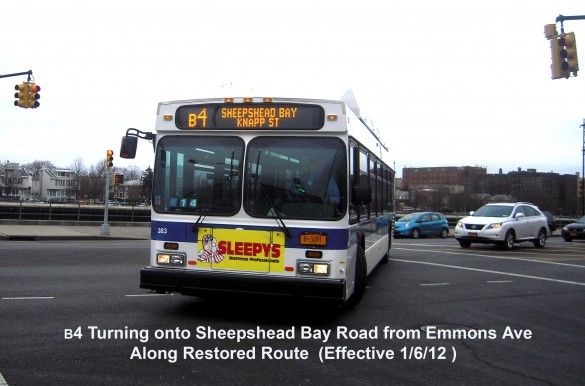
THE COMMUTE: The DOT gets an ‘Incomplete.’
Reason One: As of January 10, the Ocean Avenue Footbridge still has not reopened, although the scheduled completion date for repairs was the end of 2012.
Reason Two: Although new bus stops and signage for the restored B4 were in place by January 6, the first date of operation, the old signs for bus stops formerly located on Avenue Z between Ocean Parkway and East 14th Street were still not removed as of January 10.
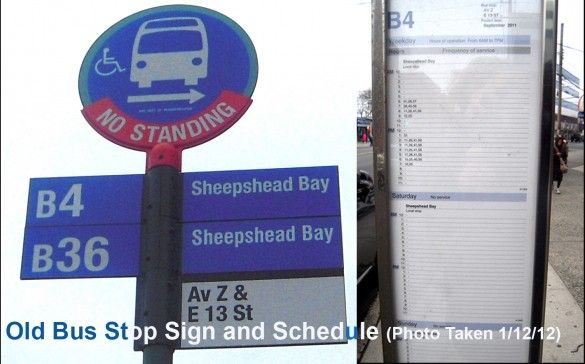
Notice the old schedule that shows no weekend service? However, to their credit, the MTA posted temporary laminated signs at each bus stop with a map showing the service change, until DOT gets its act together.
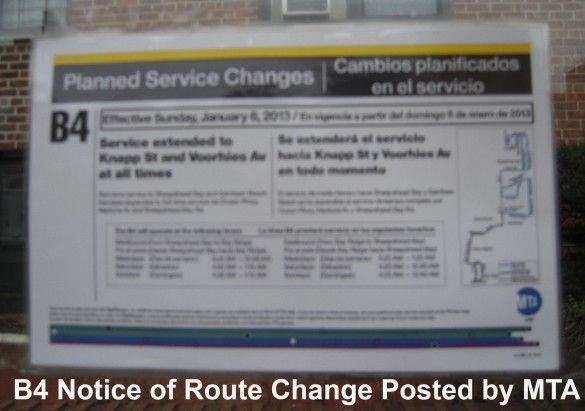
Did DOT forget to remove the old B4 signage, or have they just not yet gotten around to it? How long will it take? When the routes were cut back in 2010, it took three months for them to update all the signage. They did, however, remove the B4 bus stop on the north side of Avenue Z and East 15th Street because, unlike the other stops, it was not shared by another route.
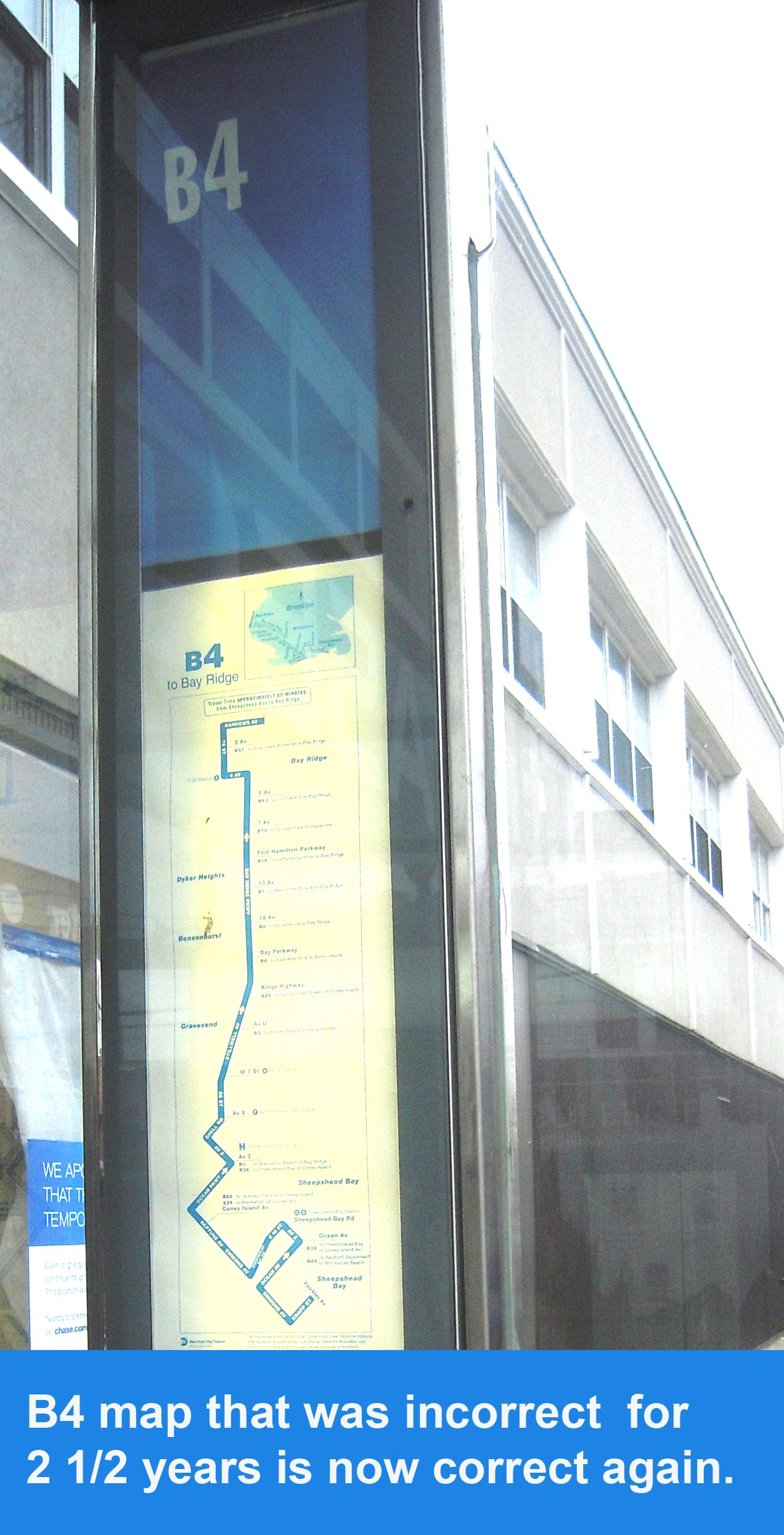
Updating signage at bus shelters, as I reported before, is another story. That should be done by CEMUSA, the company that installed the shelters under contract from DOT. Signage has not been updated on the shelters since they were constructed a few years ago. The once inaccurate B4 route map at the East 16th Street shelter is now accurate again, now that the old route was restored. There never was any indication on the shelter that the B49 also stops there.
DOT was quick to remove three B4 bus shelters when the route was rerouted off Neptune Avenue in 2010. Will they ever be reinstalled, is the question now. The reinstated bus stop on Neptune Avenue and Shore Boulevard, which once had a bus shelter, is now occupied with cars from the nearby Infiniti dealership, and there doesn’t seem to be any police enforcement.
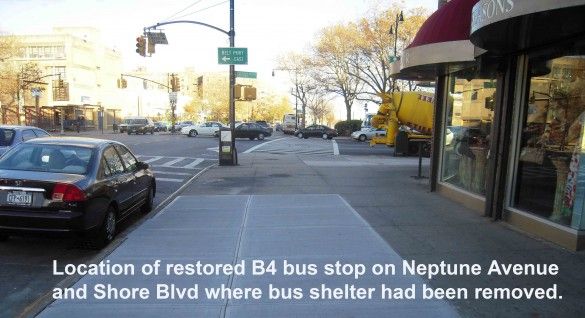
Other DOT News
On the positive side, DOT unveiled new, clearer, parking regulatory signage last week. However, the benefits of the new signage will be most noticeable in Manhattan, where a single block can have a dozen or more different, confusing, and seemingly contradictory regulations for commercial vehicles as well as non-commercial vehicles.
In Brooklyn, the major difference will be that the blue sign pointing you in the direction of the closest muni-meter will disappear and the words, “2 Hour (or 1) Hour Parking” will be replaced with “2 (or 1) Hour Metered Parking.” It will be interesting to see if DOT will replace the “2 Hour Parking” signs opposite from Bally’s — which are currently free because there are no muni-meters on that side of the street — with “2 Hour Metered Parking” signs when they update the signage.
Removing the muni-meter signs are a mistake, because one can walk in the wrong direction looking for a meter where the muni metering ends and find a summons on his car by the time he or she returns five minutes later. Perhaps the large blue signs are no longer necessary now that stand-alone meters are a thing of the past, but the information showing the direction of the closest muni-meter still needs to be shown.
MTA’s Grade: B, For “Better” Than The DOT
The MTA did a good job designing its temporary signage at the bus stops describing the changes to the B4 and posted them in advance of the change. However, they continue to mislead on the signs placed inside the buses by calling the service restorations, “Service Improvements,” contributing to their image problem.
Also, a separate sign for each borough was prepared to announce the “service improvements,” whereas, when the service cuts were announced in 2010, all the cuts for the entire city were crowded into one single sign listing only the route numbers affected. Apparently, the MTA wants you to know about these “improvements,” but did not care if you understood the service cuts. As a result, few attended the public hearings in 2010 to protest the cuts, since their impact was not fully realized. It was not until months later that riders became aware of how devastating the cuts were and began contacting elected officials to get service restored.
There was one error in the public notice signs appearing in the buses. Plumb Beach is referred to as Gerritsen Beach.
A Side Note
My informal survey last weekend of B4 and B49 ridership in Sheepshead Bay showed that buses on each route carried approximately 10 passengers per bus. I saw about six buses. Yet, the MTA saw fit in 2010 to play with people’s lives by eliminating weekend service on the B4 without any origin / destination data, but retained B49 service in Sheepshead Bay. One can only wonder what faulty methodology they used to make their decision to cut the B4 while leaving the B49 unchanged.
The Commute is a weekly feature highlighting news and information about the city’s mass transit system and transportation infrastructure. It is written by Allan Rosen, a Manhattan Beach resident and former Director of MTA/NYC Transit Bus Planning (1981).
Disclaimer: The above is an opinion column and may not represent the thoughts or position of Sheepshead Bites. Based upon their expertise in their respective fields, our columnists are responsible for fact-checking their own work, and their submissions are edited only for length, grammar and clarity. If you would like to submit an opinion piece or become a regularly featured contributor, please e-mail nberke [at] sheepsheadbites [dot] com.




